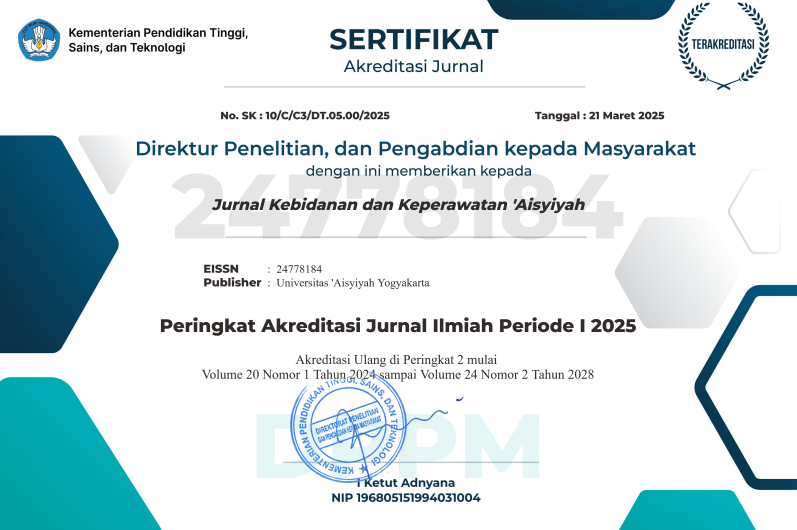Correlation between Maternal Age and Cesarean Section
DOI:
https://doi.org/10.31101/jkk.849Abstract views 1938 times
Keywords:
maternal age, cesarean section, Advanced maternal ageAbstract
Downloads
References
Aiken, C. E., Bchir, M. B., Aiken, A. R., Bchir, M. B., Cole, J. C., Brockelsby, J. C., & Bamber, J. H. (2016). HHS Public Access. HHS Public Access, 35(9), 695–699. https://doi.org/10.1038/jp.2015.62.Maternal
Australian Institute of Health and Welfare. (2013). Australia’s mothers and babies 2013—In brief. Canberra AIHW, Perinatal statistics series No. 31. Cat No. PER 72.
Badan Penelitian dan Pengembangan. (2010). Reset Kesehatan Dasar. Reset Kesehatan Dasar. https://doi.org/1 December 2013
Begum, T., Rahman, A., Nababan, H., Emdadul Hoque, D. M., Khan, A. F., Ali, T., & Anwar, I. (2017). Indications and determinants of cesarean section delivery: Evidence from a population-based study in Matlab, Bangladesh. PLoS ONE, 12(11), 1–16. https://doi.org/10.1371/journal.pone.0188074
Betrán, A. P., Ye, J., Moller, A., Zhang, J., & Gülmezoglu, A. M. (2016). The Increasing Trend in Caesarean Section Rates : Global, Regional, and National Estimates : 1990-2014. PLoS ONE, 1–12. https://doi.org/10.1371/journal.pone.0148343
Blomberg, M., Tyrberg, R. B., & Kjølhede, P. (2014). Impact of maternal age on the obstetric and neonatal outcome with emphasis on primiparous adolescents and older women : a Swedish Medical Birth Register Study. BMJ Open. https://doi.org/10.1136/bmjopen-2014-005840
Chung, S., Seol, H., Choi, Y., & Oh, S. (2014). Changes in the Cesarean Section Rate in Korea ( 1982 – 2012 ) and a Review of the Associated Factors. JKMS (2003), 1341–1352.
Dekel, S., Ein-dor, T., Berman, Z., Barsoumian, I. S., Agarwal, S., & Pitman, R. K. (2019). Delivery mode is associated with maternal mental health following childbirth. Springer.
Dodd, J., Crowther, C., Grivell, R., & Deussen, A. (2017). Elective repeat cesarean section versus induction of labor for women with a previous cesarean birth ( Review ). Cochrane Database of Systematic Reviews, (7). https://doi.org/10.1002/14651858.CD004906.pub5.www.cochranelibrary.com
Faisal-cury, A., Menezes, P. R., Quayle, J., Santiago, K., & Matijasevich, A. (2017). The relationship between indicators of socioeconomic status and cesarean section in public hospitals. Rev Saúde Pública, 1–11.
Hamilton, B., Martin, J., Osterman, M., & Et, A. (2015). Births: Final data for 2014. National Vital Statistics Reports.
Herstad, L., Klungsøyr, K., Skjærven, R., Tanbo, T., Forsén, L., & Åbyholm, T. (2016). Elective cesarean section or not ? Maternal age and risk of adverse outcomes at term : a population-based registry study of low- risk primiparous women. BMC Pregnancy and Childbirth, 1–11. https://doi.org/10.1186/s12884-016-1028-3
Kemenkes RI. (2013). RISET KESEHATAN DASAR. Jakarta.
Liu, X., Landon, M. B., Cheng, W., & Chen, Y. (2015). Cesarean delivery on maternal request in China : what are the risks and benefits ? The American Journal of Obstetrics & Gynecology, 212(6), 817.e1-817.e9. https://doi.org/10.1016/j.ajog.2015.01.043
Ming, Y., Huang, R., Zhou, W., Wang, B., Yu, H., Zhang, J., & Birth, S. (2019). Are age and socioeconomic status associated with preference for birth mode in nulliparous women in China ? Archives of Gynecology and Obstetrics, (123456789). https://doi.org/10.1007/s00404-019-05140-w
Morogoro, F. J., Mshana, S. E., Mirambo, M. M., Kidenya, B. R., & Gumodoka, B. (2014). Incidence and predictors of surgical site infections following cesarean sections at
Bugando Medical Centre, Mwanza, Tanzania. Antimycobacterial Resistance & Infection Control, 3(1), 1–10.
https://doi.org/10.1186/2047-2994-3-25
Mylonas, I., & Friese, K. (2015). Indications for and Risks of Elective Cesarean Section. Medicine. https://doi.org/10.3238/arztebl.2015.0489
Ogawa, K., Urayama, K. Y., Tanigaki, S., Sago, H., Sato, S., & Saito, S. (2017). Association between very advanced maternal age and adverse pregnancy outcomes : a cross-sectional Japanese study. BMC Pregnancy and Childbirth, 1–10. https://doi.org/10.1186/s12884-017-1540-0
Ramachandran, N., Sethuraman, D., Nachimuthu, V., & Natrajan, T. (2015). Obstetric and perinatal outcome of elderly mothers aged 35 years and above : a comparative study. International Journal of Research in Medical Sciences, 3(1), 214–219. https://doi.org/10.5455/2320-6012.ijrms20150138
Richards, M. K., Littman, A. J., Burke, A. K., & Callegari, L. S. (2016). Primary cesarean section and adverse delivery outcomes among women of very advanced maternal age. Journal of Perinatology, (May 2015), 1–6. https://doi.org/10.1038/jp.2015.204
Siabani, S., Jamshidi, K., & Mohammadi, M. M. (2019). The attitude of pregnant women towards Normal delivery and factors driving the use of caesarian section in Iran ( 2016 ). Siabani et Al. BioPsychoSocial Medicine, 1–7.
Song, G., Wei, Y. M., Zhu, W. W., & Yang, H. X. (2017). Cesarean Section Rate in Singleton Primiparae and Related Factors in Beijing, China. Chinese Medical Journal, 130(20), 2395–2401. https://doi.org/10.4103/0366-6999.216415
Straface, G., Scambia, G., Zanardo, V., Straface, G., Scambia, G., & Zanardo, V. (2016). Does the ST analysis of fetal ECG reduce the cesarean section rate for fetal distress ? Does the ST analysis of fetal ECG reduce the cesarean section rate for fetal distress ? Maternal-Fetal Neonatal Medicine, 7058(September). https://doi.org/10.1080/14767058.2016.1226794
Wang, J., Sun, H., Huang, K., Zheng, X., & Tao, F. (2017). The trend of cesarean section rate and puerpera characteristics: based on Robson classification. Wanfang Med Online.
Wang, L., Xu, X., Baker, P., Tong, C., & Zhang, L. (2016). Patterns and Associated Factors of Caesarean Delivery Intention among Expectant Mothers in China : Implications from the Implementation of China ’ s New National Two-Child Policy. International Journal of Environmental Research and Public Health. https://doi.org/10.3390/ijerph13070686
WHO. (2014). World Health Organization. European health for all databases (HFA-DB. Retrieved from http://data.euro.who.int/hfadb/
Winkel, S., Einsle, F., Pieper, L., Höfler, M., Wittchen, H. U., & Martini, J. (2015). Associations of anxiety disorders, depressive disorders, and body weight with hypertension during pregnancy. Archives of Women’s Mental Health, 18(3), 473–483. https://doi.org/10.1007/s00737-014-0474-z
World Health Organization. (2015). WHO Statement on Caesarean Section Rates Caesarean section rates at the hospital level and the need for a universal classification system. WHO, 8. https://doi.org/10.1016/j.rhm.2015.07.007
Yoshioka-Maeda, K., Ota, E., Ganchimeg, T., Kuroda, M., & Mori, R. (2016). Cesarean section by maternal age group among singleton deliveries and primiparous Japanese women: A secondary analysis of the WHO Global Survey on Maternal and Perinatal Health. BMC Pregnancy and Childbirth, 16(1), 2–7. https://doi.org/10.1186/s12884-016-0830-2
Zhang, H., Wu, J., & Norris, J. (2017). Predictors of preference for caesarean delivery among pregnant women in Beijing. Journal of International Medical Research. https://doi.org/10.1177/0300060517696217
Downloads
Published
How to Cite
Issue
Section
License
With the receipt of the article by the Jurnal Kebidanan dan Keperawatan Aisyiyah Editorial Board and the decision to be published, then the copyright regarding the article will be diverted to Jurnal Kebidanan dan Keperawatan Aisyiyah. Universitas 'Aisyiyah Yogyakarta as the publisher of Jurnal Kebidanan dan Keperawatan Aisyiyah hold the copyright regarding all the published articles in this journal.
Jurnal Kebidanan dan Keperawatan Aisyiyah is licensed under a Creative Commons Attribution-ShareAlike 4.0 International License.
















